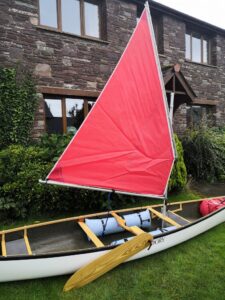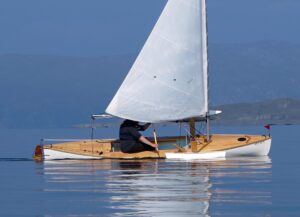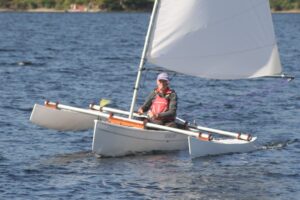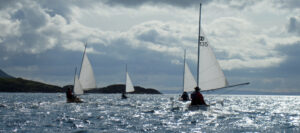Choice of canoe
There are different ways to achieve the ideal of a safe, light, fast, portable, touring boat.
A century ago canoes were divided into four categories; pure paddling canoes, sailable paddling canoes, paddleable sailing canoes and pure sailing canoes. We can also classify canoes as decked or open and monohull or multihull.
We are a canoe sailing group, so pure paddling canoes need not concern us (though of course many of us are also paddlers).
Pure sailing canoes need not concern us either. The IC10 is an example. It is a high powered racing machine which wouldn’t be recognised as a canoe by many canoeists. At present there are no pure sailing canoes in the OCSG. They lack the versatility which attracts most of us to canoe sailing.
A sailable paddling canoe is primarily a paddling canoe but it carries a small auxiliary sailing rig. The main means of propulsion is paddling with a small and perhaps less efficient sailing rig being chosen because it is easier to stow and is less likely to interfere with paddling. This can be a very valid boat for adventure sailing, but at the time of writing (Jan 2011) it is under-represented in the OCSG. The development of this type of sailing has been held back by the unfortunate concept of “improvised sailing”, with small, poor-quality homemade sails.
The first recreational canoes, the Rob Roys of the 1860s, were decked sailable paddling canoes.
A paddleable sailing canoe is a boat in which sailing is the primary means of propulsion.
This is the type of boat favoured by most members of the OCSG.
Paddles are carried for when the wind drops but the sailing rig is bigger and more powerful. Some small compromises in ease of paddling may be accepted in the pursuit of greater sailing performance ……. ” Sail when you can, paddle when you must “.
Getting a Sailing Canoe
There are three ways to get a sailing canoe:
- buy it
- build it yourself
- convert a paddling canoe.
If you buy a sailing canoe it should have been built to the relevant safety standards, like anything else you buy. In Europe these standards are set down in the Recreational Craft Directive, commonly known as the “RCD”. The boat will have on it a CE mark and come with a manual and certificate of compliance.
If you build your own boat you are not obliged to comply with the RCD unless you sell it within five years. However you may take the view, as we do, that following the same safety standards is sensible, even if you are not legally required to do so.
The same applies if you are converting a paddling canoe.
Pure paddling canoes are exempt from the requirements of the RCD at present. Paddling canoes with a very small auxiliary sail are also exempt. Open canoes are often bought without any fitted buoyancy and there is some debate in the paddling world about whether there is a need for additional buoyancy. But bear in mind that, as soon as you put any sail on a canoe, you are likely to venture much further from the shore in search of better wind and that your sail may make a capsize more likely.
In our opinion the provisions of the RCD as regards buoyancy and capsize recovery represent a minimum and achievable standard for any sail-equipped canoe.
As it applies to commercially available sailing canoes, the RCD is principally concerned with buoyancy and capsize recovery. Remember that this is a test of the boat, not the crew (an MOT, not a driving test).
A practical interpretation of the RCD
We interpret the relevant parts of the RCD as follows; that there are four ways in which a boat may comply with the safety standards.
It must do at least one of the following
- The boat must not capsize in the conditions for which it is certified.( This may apply to some multihulls.)
- The boat must self right with the crew in it. (This is normal for a yacht but as it requires heavy external ballast it is unlikely to be relevant to the sailing canoe.)
- A standard person of 75kg has to be able to right a capsized boat, re-enter it and bail it.( This is a minimal requirement for a sailing canoe.)
- The standard crew has to re-enter a swamped boat and the boat must support them for at least ten minutes with three quarters of the gunwale above water. (We don’t think this is adequate for a sailing canoe which is sailing in remote places which are more than ten minutes away from the rescue boat).

These requirements can only be met by providing buoyancy. This can be either tanks, closed cell foam blocks, bags or a combination of these.
If the buoyancy is provided by tanks they need to be reasonably air tight.
When fitting out an open canoe for sailing, most people will use buoyancy bags or foam blocks to enable them to recover from a capsize. We have found that side bags are necessary in addition to the end bags which are more familiar to canoeists. There is no point in fitting buoyancy bags or blocks unless they are well attached. As a rule of thumb we would suggest that each anchor point should support the unloaded weight of the canoe (this is easy to test). Glue joints may deteriorate over time and should be tested regularly (gaffer tape won’t do!) Each side bag needs to have a buoyancy of at least 100lbs. (There is a link to further reading about Buoyancy at the bottom of the page.)
An OCSG meet may be a good place to test your boat. Contact the organiser beforehand.
When choosing an open canoe for converting into a sailing canoe, depth and beam are important factors. Generally boats with a minimum beam of around 36 inches (0.9m) and a depth of about 14 inches (35cm) are preferred. Shallower boats tend to be too wet and can swamp too easily in waves and narrower boats tend to be a bit too tippy and not have enough stability to hold up a decent sized sail.
When building or buying a sailing canoe you can choose to have an open boat or a decked boat. Open boats are cheaper, lighter and easier to load, while decked boats are heavier and more expensive, but they are more seaworthy, less likely to capsize and easier to recover after a capsize. They also tend to be drier.

Small add-on outriggers can greatly increase the seaworthiness of any decked or undecked sailing canoe. We do not know of any canoe capsizing accidentally while using small outriggers but unless outriggers are so big as to absolutely prevent the canoe from capsizing, they have to be small enough for it to be rightable. This is a somewhat technical subject and will be the subject of a separate article (see the bottom of the page). Over recent years an increasing number of our members have chosen to fit outriggers for sailing and for use on the sea where capsize might be more serious.

Purpose-built trimaran canoes can be uncapsizable and these are favoured by some members for use on the sea. They would also be a sensible choice for anyone else who chooses not to risk a capsize. The disadvantage is that these boats are more expensive and more cumbersome, although they do tend to be faster.

The RCD does not concern itself with the sailing rig. However we have found by experience that safety can depend on having an efficient sailing rig. Because of the limited stability of a canoe we cannot compensate for inefficiency of the rig by increasing sail area.
A safe haven can often be upwind. Unless we know that we can paddle there, we need an efficient windward rig. In case the weather deteriorates before we get there, we need to be able to reduce our sail area (reef) on the water and continue sailing to windward with this reduced sail. It may also be necessary to take the rig down whilst on the water, so an ability to do this quickly and neatly is important. Large rigs that cannot be easily reefed or stowed have no place on cruising sailing canoes.
If you are fitting a rig yourself make sure you understand the large forces that the rig can exert on your canoe. Mast thwart and mast feet can have forces of several hundred pounds on them in strong winds and they should be securely fastened onto the canoe. Rudders and leeboards also take large forces and should be strong and securely mounted.
Dave Poskitt (Jan 2011)
Since Brexit, the names of the EU directive may have changed but the UK is still using essentially the same standards for small sailing boats.